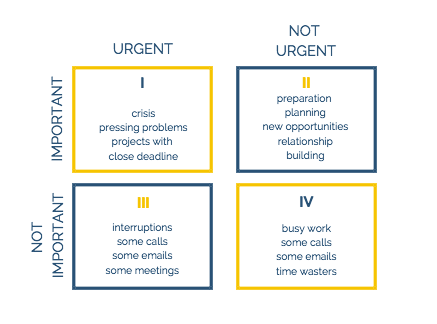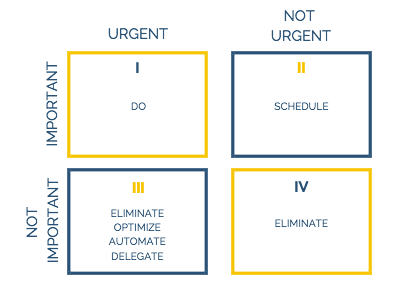Streamline Your Work: Part I
Episode #7 of the course Streamline your life to have more time for what matters by Liz Huber
Welcome back!
Since work makes up the biggest daily chunk for most people, we will give it some extra attention and split up the streamlining process in two parts: Today, I will show you a powerful method to analyze and categorize your entire workload, which is the basis for applying the powerful streamlining strategies you will learn tomorrow.
Let’s go!
Analyze
There is no other method better suited for analyzing and optimizing work-related activities than the Eisenhower Matrix, also called Urgent-Important Matrix. In fact, this tool has the potential to 10x your effectiveness at work! It was invented, as the name indicates, by Dwight D. Eisenhower, 34th President of the United States, when he was struggling to prioritize his many tasks. The result was a matrix consisting of four quadrants that classify activities according to two parameters: urgency and importance.
In today’s world, the Eisenhower Matrix looks something like this:

Do you already know which quadrant makes up most of your work week? Here are more indicators:
Quadrant I: You feel like you are constantly in emergency mode. Most of the projects you are working on demand your immediate attention due to a pressing deadline.
Quadrant II: You feel like you are on top of things because of careful planning, preparation, and prevention. You can focus your time on high-leverage projects, new opportunities, learning, and relationship building.
Quadrant III: You spend most of your time on activities that require your immediate attention but are not necessarily related to your top priorities. You are constantly interrupted and deal with un-important meetings, non-critical phone calls, and emails. You feel like you are always dealing with issues that are important to others but not related to your own priorities.
Quadrant IV: You often feel like you are wasting your time. You spend a lot of time on busy work that is not directly related to your goals or on social media, videos, games, and pointless web surfing.
Once, you understand the basics of the matrix, you are ready to dissect your daily tasks, Eisenhower-style:
1. Make a complete list of all your work-related activities by screening your to-do list and calendar. Pay special attention to all recurring tasks, like weekly meetings, reports, and emails, since they bear the highest potential for optimization. Don’t be shy to add tasks that you WISH you could do but don’t have time for.
2. Classify your tasks according to urgency and importance using the Eisenhower Matrix.
3. Estimate the time you spend in each quadrant in a typical week. For most recurring tasks and meetings, this should not be a problem. However, putting a number on your personal time wasters like social media is tricky. If you are ready to know the truth, track your browsing habits at work with tools like Webtime Tracker (Chrome Extension) and RescueTime (for all operating systems), as well as your mobile app usage with tools like AntiSocial. Let these tools run in the background for a week, and then analyze how you are really spending your time at work.
The most effective people spend 70% of their time working on high-leverage projects from Quadrant II. As a result, they are able to make significant progress toward their goals, actively prevent crises from happening, and lead a more balanced, calm, and focused life.
The majority of people, however, spend almost no time in Quadrant II because they are so busy with Quadrant I, III, and IV activities. But don’t worry, with a few simple shifts, you can claim back valuable time in your job and finally leave the office earlier or focus on new exciting opportunities! Here is what you need to do with each quadrant to free up your time:

Quadrant I: Focus on urgent and important activities first, and get them done.
Quadrant II: Block time for important but not urgent activities.
Quadrant III: Eliminate, optimize, delegate, or automate as many urgent but unimportant activities as possible.
Quadrant IV: Completely eliminate tasks that are neither urgent nor important.
Tomorrow, you will learn exactly what to do with each quadrant!
Take Action Today: Analyze your workload with the Eisenhower Matrix!
Happy streamlining,
Liz
Recommended reading
Strategic Focus: Five Steps to Avoid Busywork
“You’ve Been on Your Phone for 160 Minutes Today”
Recommended book
Share with friends

